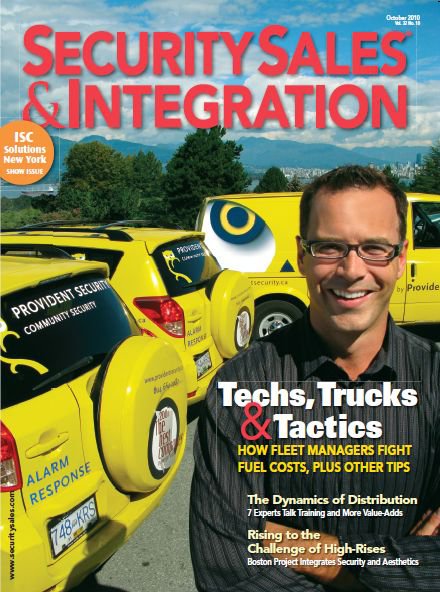
Fleet Managers Share Best Practices
 No two fleets are alike, but fleets that serve the same industry tend to share more than a few common characteristics. For security system installers, the big, white van with shelves in the back and ladder racks on the roof has long been the standard bearer.
No two fleets are alike, but fleets that serve the same industry tend to share more than a few common characteristics. For security system installers, the big, white van with shelves in the back and ladder racks on the roof has long been the standard bearer.
Throughout the past several years, however, a challenging economic climate and soaring fuel costs have forced fleet managers in the installing security industry to consider new options.
The changing business landscape has affected operational decisions such as whether to purchase or lease, how vehicles are maintained, the need to implement new efficiencies, managing drivers and other aspects of fleet management.
Three installing security contractors, each with varying fleet sizes, share their insights and vehicle management methods that have proven successful in their operations.
Procurement and Remarketing
According to SSI’s 2010 Security Industry Demographic Census, which polled managers from all levels of installing security dealer and systems integration organizations, 94 percent of surveyed companies buy their fleet vehicles, opposed to leasing. That’s an increase of six percentage points compared to the previous survey results in 2008.
That study (March issue) also revealed that many companies have pared the number of vehicles in their fleets – likely the result of cost-cutting measures. In 2008, the average number of fleet vehicles at a typical installing company was 10. At the beginning of this year that number had fallen to six.
Mike Jagger, president and founder of Provident Security in Vancouver, British Columbia, Canada, has built his 36-vehicle fleet by procuring his installers’ Chevrolet Safari and Astro vans from a car dealership. He prefers to lease, but on an extended term. Jagger’s operation is unique in the industry for operating response as well as installation vehicles.
“Our usual lease term is 30 months, which is based on estimated wear and tear,” Jagger says. “That could be 10,000 kilometers [6,214 miles] per month for a guard vehicle. Our pattern has been heavy initial use, then a retirement phase.”
Cycling higher-mileage vehicles into more limited use helps the vehicles meet the 30-month lease term, but maximum efficiency remains Jagger’s primary goal.
“At end-of-cycle, some are still worth something when they’re returned,” he says. “We just look at the vehicles as something we need to get the job done.”
Dale Bonifas, vice president and second-generation owner of Alarm Detection Systems Inc. in Aurora, Ill., would agree. He manages his 120-vehicle fleet with little regard for resale value, preferring instead to send retired vehicles to the crusher.
“We have considered remarketing the vehicles,” Bonifas says. “Our CFO has studied the advantages and disadvantages. There are good programs out there. But one of our concerns is that we don’t want anybody driving around in an old vehicle with our graphics and phone number on it.”
Tim Creenan, founder and CEO of Amherst Alarm Inc., located near Buffalo, N.Y., operates his company’s vehicles for about seven years. Creenan then moves his retired units the old-fashioned way, through the local want ads.
“One reason we’re able to keep them running so long is that our techs do an inspection each week. They are high-mileage and a bit worn,” he says. “But with the shelving and ladder racks, they’re just right for somebody like a contractor.”
Creenan has added two Chevrolet HHR panel vans and a Ford Transit Connect (TransCon) to a 15-vehicle fleet that had been comprised entirely of full- and midsize GMC and Chevrolet vans.
“My father sells GMC trucks, and he used to sell Chevys,” Creenan says. “I guess you could say I have a bias there.”
The HHR’s smaller size limits its use to personal vehicles for Amherst Alarm’s installation and product managers, but Creenan considers the Transit Connect an early success. “No bad feedback at all,” he reports. “They could probably replace the Astro vans.”
The TransCon’s high profile also offers additional space for vinyl-wrap graphics, which now decorate every new addition to the fleet.
Indeed, vehicle graphics represent a highly cost-effective advertising method. For many installing companies it is the leading marketing tactic. The designs can range from a simple company logo to a full-color, billboard-style advertisement.
While the sky is the limit, a less-is-more approach is advised.
“The challenge with those wraps is that you can put anything on – you can literally fill every inch with full-color images and it often becomes too busy and distracting,” Jagger says.
Upfitting for Efficiency
For Jagger, the journey toward a more efficient fleet began four years ago when he became interested in the Lean management system credited to Toyota Motor Corp. The goal is to reduce waste by eliminating processes that offer no benefit to the customer. When he opened the back doors of his installers’ Chevrolet Safari and Astro vans, he saw shelves and bins that were full of junk.
So Jagger implemented a 5S project, a Lean process that stands for sorting, straightening, shining, standardizing and sustaining.
“We had techs digging through pieces of cable and broken parts,” he says. “We were shocked at how much extra stuff was in there. Now, they carry a lot less. Some of the vehicles don’t even have racks; they’re down to just plastic kits. We have found that, if there’s a space, people will find a way to fill it.”
His colleagues have taken a somewhat less scientific approach, relying on their own experience and that of their installers to keep their vehicles’ weight down.
“Our upfitter is Kaminski and Sons, here in Buffalo, and the manufacturer they use is Adrian Steel,” Creenan says. “By now, we know exactly what we want in there.”
Bonifas has taken advantage of certain car manufacturer perks to outfit his vans more cost-effectively, all the while keeping a keen eye on limiting excessive cargo.
“The Chevy vans, for quite a while, have offered a package that includes basic shelving and ladder racks for free,” says Bonifas. “We have cut down on inventory. We try not to keep too much extra equipment in the vehicles.”
Maintenance Matters
Bonifas has worked for the company that his father, Robert, founded in 1968, for more than 30 years. By the mid-1980s, it was clear that the company’s fleet had grown to the size for which in-house maintenance was the only answer.
“We now have our own shop with three service bays,” he says. “That’s what works for us. Once you’ve been in the same vehicles for a number of years, you know what you need.”
Those same vehicles include diesel-powered Volkswagen Jettas and Passats, which now represent two-thirds of Alarm Detection Systems’ fleet. Bonifas has been buying VWs since the early ’80s, when the Rabbit – precursor to the Golf – was getting 48 miles per gallon. Bonifas believed he had found the ideal service vehicle.
“It’s not all that common in the industry, but they’re much easier to park and for the jobs they’re used for they can carry all the equipment we need,” he says.
Creenan and Jagger both rely on local shops for repairs, and maintenance is a responsibility shared between management and the drivers. They point to the importance of ensuring that routine maintenance never goes unperformed.
“When we had problems, it always came back to a poor system,” Jagger says. “If you miss an oil change and end up having to replace the engine, your first instinct is to say, ‘What idiot didn’t notice it needed an oil change?’ Well, if you’ve got three or four guys driving one vehicle in 24 hours, who’s the idiot?”
Caring for a company vehicle also entails maintaining its exterior with the purpose of conveying professionalism and attention to detail. Companies that operate fleets across many industries elect to use prepaid programs with a local carwash business. In many cases, technicians receive a fleet membership card, thereby eliminating the hassle of handing out cash or a company credit card to each employee.
Provident elected to go a different route and had its own carwash built. The construction required the addition of some extra plumbing, especially drainage, but it has provided convenience for employees, along with ensuring the vehicle exteriors are not damaged.
“The driver is responsible for cleaning the vehicle after every shift,” Jagger says. “The vehicles can’t go through a regular carwash due to the vinyl wraps.”
Fuel Cards and Routing Software
Each of the executives interviewed for this story has, at one time, operated his fleet without a fuel card. Each, in turn, became a convert.
“Not having a fuel card became unruly,” Jagger recalls. “We tried sharing a credit card. It didn’t work.”
Jagger switched to Petro-Canada, whose stations can be found almost anywhere north of the border. As Canada’s 11th-largest company, the fuel provider’s massive scale allows it to offer several programs to fleets, each carrying a per-liter discount. Every penny counts, but Jagger, Creenan and Bonifas each enjoy the added benefits of a fuel-card partnership as well.
“We use Wright Express credit cards,” Creenan says. “They are good at almost every gas station and we get reports on mileage, etc., from them. We used to use one local gas station chain’s private-brand card, but that limited use to their stations.”
“Our fuel-card provider is T-Chek,” Bonifas says. “They provide mileage reports, and those are very useful. Our lead mechanic uses them to check on usage and keep track of oil changes.”
Keeping track of vehicles and drivers is another major concern in the security game. Without even realizing it, Creenan and Jagger were well on their way toward GPS-enabled tracking before either adopted the technology.
“The provider found us through our dispatch software provider, and they were actually able to integrate it with the dispatch software,” Creenan says. “The install was easy; they did all the vans in one night.”
Jagger’s GPS system is similarly tied into his alarm response software and connects to his drivers’ handhelds as well. In snowy Western New York, Creenan also relies on the software to minimize idling.
“The GPS is programmed to give us an alert whenever they idle for more than five minutes,” he says. “That’s especially important in the winter months. Now the software generates a report automatically. It even shows if a driver was speeding.”
Bonifas uses tracking software as well, but cautions other security executives against the notion that it may one day replace dispatchers.
“We do use GPS to locate the closest vehicle and to verify time entries,” he says. “We do not use it to automatically route service technicians, as much of our calls are dependent on skill level and appointment times. This has been a very valuable tool for our service dispatchers.”
Published September 29, 2010 · Security Sales & Integration · Written by Tariq Kamal
Installation Services
Provident has assembled a first class team of professional alarm technicians who install the latest alarm, CCTV and access control systems.
Read More about how installation works and what we can do for you.

Monitoring & Response Services
The most important reason for installing an alarm system is to generate an immediate response.
Read more on the intrusion detection monitoring services we provide.

Book An Appointment Today
Real security takes more than just an alarm. Our security professionals will show you how to five-minute proof your home or business so that you get the most out of your security investment.
Book Appointment